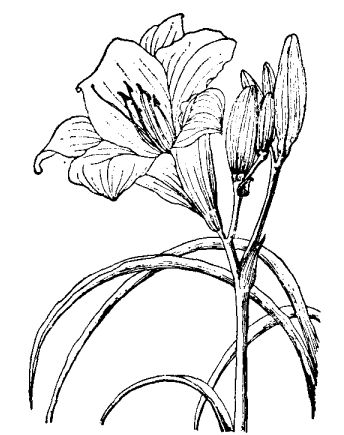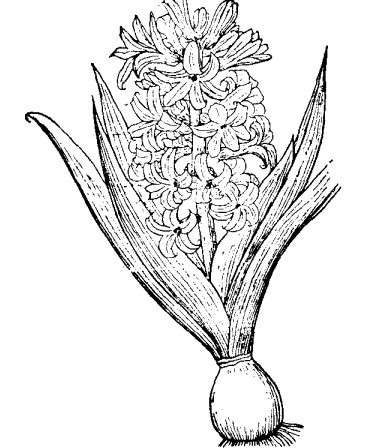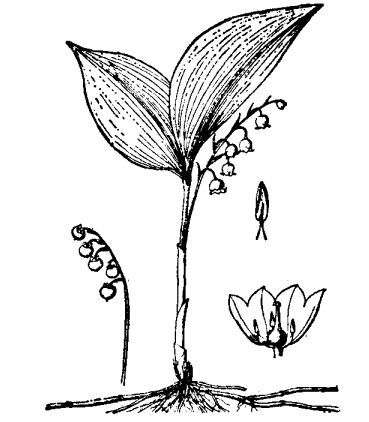Introduction to the main species of Hemerocallis
1. North cauliflower (Hemerocallis, H.litioasphodclusL-LvaL.): leaf blade dark green, banded, 30 Murray 60 cm long, 0.5 Murray 1.5 cm wide, arched. Flowers 6-9, showing a terminal open panicle, light lemon-yellow flowers, shallow funnel-shaped, about 9 cm in diameter, with fragrance. Scape is about 125 cm high, flowering from May to July. The flower bud is the famous "golden needle vegetable", which can be eaten. It is originally from China and Japan.
2. Yellow flower (Jinzhonglai, H.citrinaBaroni): the leaves are broad, dark green, 75 cm long, strong and compact. Flowers pale lemon yellow, abaxially brownish halo, perianth 13-16 cm long, lobes narrower, pedicel short, fragrant. The florescence is from July to August. Flowers can not fully bloom in strong light, often bloom in the evening and close before noon the next day. The buds are edible. It originated in our country.
3. Small cauliflower (small yellow flower, minotMill.): leaves green, about 50 cm long and 6 mm wide. There are 6 flowers in 2muri, yellow, with brown halo on the outside, about 5murmur10cm long, fragrant. About 25 centimeters high. Florescence 6m / m-August. The buds are edible. It originated in our country.
4. H.mdendorfjiiTrautyetMey.: the leaves are 30cm long and 45cm long and 2.5cm wide, which are lower than scape. Flowers 2MUE 4, yellow, fragrant, Flower tube cylindrical, 1.3 cm long, pedicel very short, with large triangular bracts. Flowering in July. Originally from Japan and eastern Siberia of the Soviet Union.

Introduction of main varieties of Hemerocallis
Picture: Hemerocallis
[FAQ] introduction of the main varieties of Hemerocallis
[expert answers]
Hemerocallis is also called Hemerocallis. There are about 20 natural species and 8 species in China.
1. Hemerocallis hemerocallis (Hemerocallis): native to China, with dark green banded leaves, 30-60cm long and 0.5-1.5cm wide. Arch bend. There are 6-9 flowers, lemon-yellow flowers, shallow funnel-shaped flowers, about 125cm in height and 9cm in diameter. The flower bud is the famous "cauliflower", which can be eaten.
2. Cauliflower (yellow flower): the leaves are broad, dark green, long 75cm, wide 1.5~2.5cm, there are about 30 flowers on the inflorescence, and the bracts below the inflorescence are narrowly triangular; it is distributed all over the country, especially in Guanjiazui Town, Qidong County, Hunan Province, which is the national origin of cauliflower.
3. Hemerocallis: long leaves 30~45cm, inflorescences with 2-4 flowers, yellow and fragrant, petals 8-10cm long, pedicels very short, flowers compact, with large triangular bracts. Florescence in July
4. Hemerocallis tong: long leaf 74cm, high scape 120cm, apricot yellow, deep throat, short funnel-shaped, fragrant.
5. Cauliflower: high 30~60cm. Leaves green, about 50cm long, wide 6cm. With 2-6 flowers, yellow, brown halo, long 5~10cm, fragrant. Blossom in the evening. The florescence is from June to September, and the buds are edible.
6. Red pirate Hemerocallis: strong disease resistance, low demand for soil, waterlogging and drought resistance. The height is 25 to 30 cm, the florescence is from late May to early October, and the annual tillering rate is 8.
7. Hemerocallis Hemerocallis: the height is 40ml / 45cm, the color is complex, the florescence is from June to September, the annual tillering rate is 5-7 times, and it can survive the winter naturally in the environment of minus 20 degrees.
8. Z300 Hemerocallis: the height is 30-35 cm, the flowering period is from the end of May to the beginning of October, the flower color is red, the annual tillering rate is 15-20 times, the requirement for soil is low, the ability to resist diseases and insect pests is strong, and it can survive the winter naturally in the environment of minus 30 degrees. It is an excellent variety of day lily in landscaping.
9. Autumn red hemerocallis: 35-40 cm in height, flowering from May to October, and 6 annual tillers.
10. Hemerocallis: height 30-35 cm, florescence May-October, annual tillering rate 12; Children's festival Hemerocallis, height 35-40 cm, florescence June-October, annual tillering rate 6.
[editor's comments] the above are some of the main varieties of Hemerocallis introduced to you by the first Agricultural Economics. More related information, such as "Prevention and Control of Common Diseases and insect pests of Hemerocallis", "breeding methods and points for attention of Hemerocallis", "cultivation techniques of Hemerocallis", etc., please follow the first Agricultural Economics related columns or special channels, we will try our best to provide you with more, more comprehensive and more professional information!
Introduction to the Propagation methods of Hemerocallis
Because of its short plant and long florescence, Hemerocallis is a polyploid dwarf variety treated by high-tech means, which is very suitable for ground cover plant. Nowadays, Hemerocallis hemerocallis is often used to decorate flower beds and road isolation belts. It is an excellent garden flower integrating foliage and flowers. Artificial propagation of Hemerocallis can be done by sowing, dividing plants, dividing buds and tissue culture.
Daylily
1. Sowing method:
Sowing is a method of rapid and mass production of seedlings, but because of the low germination rate of seeds, it needs to be soaked and germinated before it can be planted one year after sowing. Enter the seed collection period around September every year, which requires strong plant growth, full fruit and no diseases and insect pests. Sow the seeds in the following spring.
The nursery bed should be fully fertilized first. The bed is 1.3 to 1.7 meters wide and 30 meters long, and drainage ditches are dug on both sides. When sowing, open a shallow trench with a depth of about 3 cm every 20 cm, sow the seeds evenly into the ditch, cover a layer of fine soil, and then cover a thin layer of fine sand. Watering and weeding should be done before seedling emergence, and good soil moisture can be maintained so that seedlings can be planted in autumn. 2.5 kilograms of seeds per mu of seedbed, which can raise 50 to 60 thousand seedlings.
The seeds can also be sowed and sowed in the open field after seed sowing and germination, with a sowing amount of 5 to 7 kg per mu and sown with flat strips. Trench according to the row spacing of 30 cm, about 3 cm deep, sow a seed every 3 to 5 cm, wait for the plant to grow 2-3 leaves, apply thin human feces once. Winter with a small arch shed to protect against cold, strengthen field management after the beginning of spring, can be transplanted in August. Seeds collected from evergreen hemerocallis can be sown directly or stored at room temperature.
Second, the method of dividing buds:
A split bud refers to a small plant on the stem of a day lily. The flower bud can be cut from the flower stem and, if large, can be further divided before planting. The transplanted flower buds can take root after a week. The rooting flower buds can be used to propagate plants, increase the number of plants planted, and finally improve the economic benefits.
3. Tissue culture method:
In tissue culture, young leaves, filaments, flower moss and other organs were used to culture plants. The method is to induce young organs to produce callus, and then use appropriate medium to culture young plants under suitable conditions such as warm and humid phosgene. Then the seedlings were pseudo-planted in the nutrition bowl, and the seedlings were cultivated for a period of time, and then planted. But this method has not been widely accepted.
Fourth, the method of dividing plants:
Dividing hemerocallis clumps is the most commonly used method of reproduction. The operation of this method is simple, the plant is easy to survive and the growth is consistent. Ramet can dig out all the mother plant cluster and replant it, or dig out a part of the plant from one side of the mother plant cluster to make seedlings, leaving behind to continue to grow.
Ramets are mostly carried out before sprouting in spring or after defoliation in autumn. When the ramets are transplanted in spring, they can bolt and blossom in the same year, and in autumn, they can sprout and blossom the following year. Plants with exuberant growth, many buds, good quality and free from diseases and insect pests should be selected when transplanting.
When ramet, dig a part of the tiller of the plant clump as the seedling, dig the part with root, cut it from the shortened stem, cut off the old root, rotten root and diseased root, retain the fleshy root as far as possible, cut it short properly (about 10 cm) and then plant it. Planting should be carried out in sunny days, while digging seedlings, while dividing seedlings, while planting seedlings, as little as possible to hurt roots, so slow seedlings fast. Generally, the plant is divided once every 2 to 3 years to ensure the exuberant growth of the plant.
- Prev

Cultivation, propagation and management of hyacinth
[alias] foreign daffodils, colorful daffodils. Liliaceae, hyacinth genus. [morphology] perennial herbs, bulbs spherical or oblate, outer capsule purplish blue or white, etc., related to flower color. Leaves 4-6, basal, hypertrophic, banded-lanceolate. Scape 16-45 cm high, hollow
- Next

Cultivation and propagation methods of lily of the valley
[Alias] Monarch Shadow Grass, Grass Jade Bell. [Family] Liliaceae, lily of the valley. [Description] Perennial herbs, up to 30 cm, with transverse and branched rhizomes underground. Leaves 2--3. Basal and erect, elliptic or oblong-ovoid, 13 - 15 cm long, 7. 5 cm wide, sharply pointed
Related
- Fuxing push coffee new agricultural production and marketing class: lack of small-scale processing plants
- Jujube rice field leisure farm deep ploughing Yilan for five years to create a space for organic food and play
- Nongyu Farm-A trial of organic papaya for brave women with advanced technology
- Four points for attention in the prevention and control of diseases and insect pests of edible fungi
- How to add nutrient solution to Edible Fungi
- Is there any good way to control edible fungus mites?
- Open Inoculation Technology of Edible Fungi
- Is there any clever way to use fertilizer for edible fungus in winter?
- What agents are used to kill the pathogens of edible fungi in the mushroom shed?
- Rapid drying of Edible Fungi

